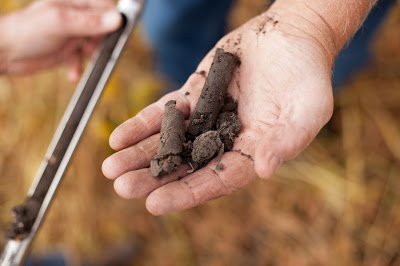June 21, 2017

By Fabian Fernandez and Daniel Kaiser
The pre-sidedress nitrate test (PSNT) is a tool for making decisions on supplemental nitrogen application. Taken during June prior to side-dress N application around the V6 stage of corn growth, the PSNT offers a way to assess insufficient N in the soil. It offers guidance for efficient N management, but only if carried out correctly. Watch our video with Extension Nutrient Management Specialist Fabian Fernandez and read on for tips to make the PSNT count
When deciding where to use the PSNT test, look to fields with large potential for mineralization, like fields coming off of alfalfa or manured fields, and those with substantial carryover nitrogen from the previous growing season. One of the reasons the PSNT is conducted in June is to quantify nitrate that has been produced from mineralization of organic nitrogen. Prolonged wet and cool conditions in the soil can slowdown mineralization, and thus reduce the accuracy of the PSNT values. Keep this in mind when assessing results, as slowed mineralization could lead to lower-than-actual nitrate values.
1. Be prepared. Bring a cooler with ice packs to prevent microbial activity and store samples until they can be dried.
When a soil sample is taken the soil in the sampling bag is still biologically active. Microbial processes cause transformation to and from the nitrate form of N and are moderated by temperature and moisture in the soil, so the amount of nitrate can be change depending on how a sample is transported and stored prior to analysis. In order to prevent the accumulation or depletion of nitrate in a soil sample, avoid temperature fluctuations as prolonged high temperatures can affect the accumulation of nitrate in soil samples, giving an inaccurate reading.
2. Spread samples out on a table in a dry room with airflow to dry. Use paper food boats to organize samples and prevent contamination among samples.
If samples need to be stored for long periods of time or shipped, drying is the most effective way to stabilize nitrate levels in the soil samples. Air or oven dry samples as quickly as possible to keep nitrate levels accurate. Be careful when drying soil in bags provided by soil testing labs. Some soil bags are lined which help prevent the bags from absorbing water from the soil but also reduce the ability to dry samples themselves.
3. If you’re sampling fields were N is banded, take three to four samples within a given area and combine them into one sample. Start near the corn-row and collect the other three samples perpendicular to the row. In 30 inch rows, space out samples every 7.5 inches across the row.
There is no set area where the samples should be taken from in a field, but grid and zone sampling strategies can help determine if portions of the field need supplemental N. Collect at least 12 cores from an area no larger than 10 acres and homogenize the samples so the value best represents the average soil nitrate concentration for that area.
4. When interpreting PSNT results, keep in mind historic management and performance of your fields.
A test showing 25 ppm or greater is not likely to need supplemental N. At 21-25 ppm, nitrate levels are likely adequate and tests of 20 ppm or lower are more likely to require supplemental N. For those fields testing at 20 ppm or lower, the rate of N fertilizer required can be subjective and there are no clear guidelines at this time on the rate of fertilizer required based on those values. Use management history and knowledge of the field sampled to decide how much fertilizer to apply.
Support for this project was provided in part by the Agricultural Fertilizer Research & Education Council (AFREC).
Originally posted by the University of Minnesota Extension. .
You May Also Like




